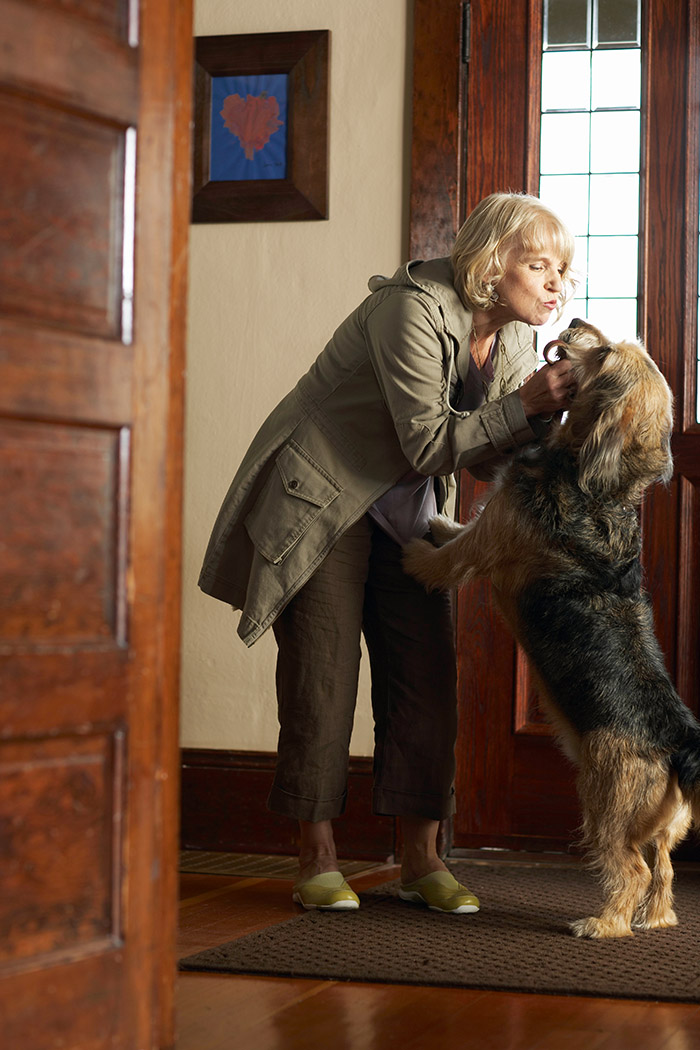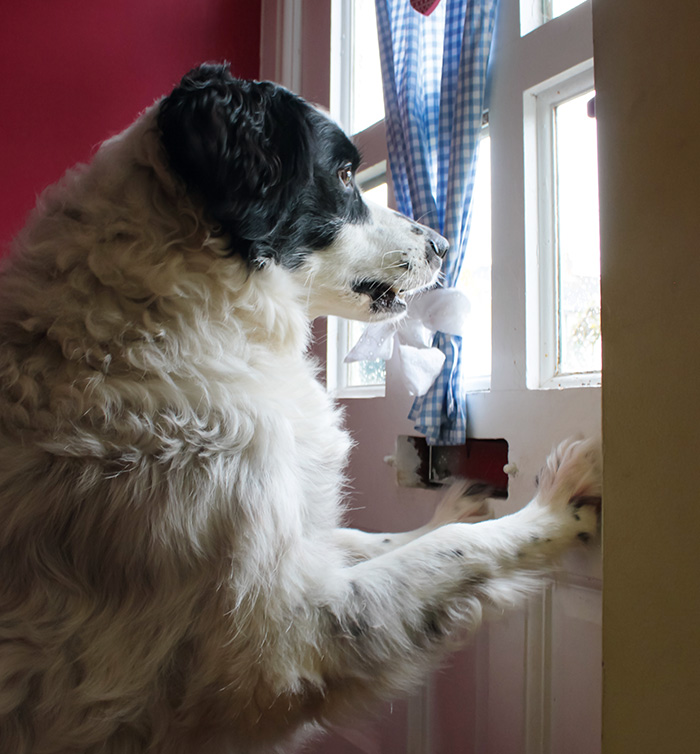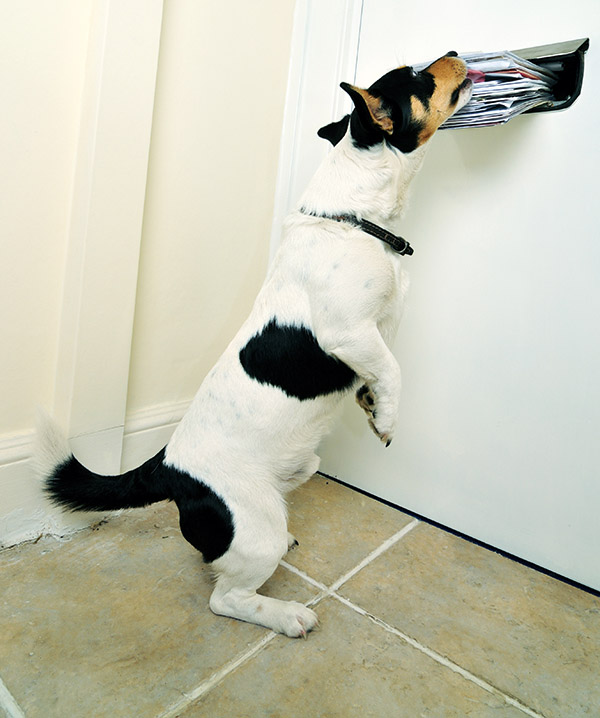We spend a lot of time teaching our dogs to sit, stay, and come when called to keep them safe outside, but teaching good manners around the house can be just as important, says Toni Shelbourne.
Teach your dog to wait at the door
If your dog tries to push through the door to escape outside whenever it’s opened, teach him to wait there:
1. Pop a lead on him so you can contain him and easily teach the exercise. Have some yummy treats ready in a treat bag.
2. Begin with a closed internal door, as it’s less exciting than the front door. Ask him to sit on the side that
opens away from him. Ask him to wait, also using a hand signal; an open palm facing towards him usually works well.
3. Position yourself in front of your dog and open the door slightly. If necessary, keep the lead short, and use your body position to encourage him to remain in position. If he does, reward him with a treat.
4. Now try opening the door a little wider while reinforcing the sit and wait with voice, hand gesture, and body position. Reward lavishly for maintaining position. If he moves, close the door and start again.
5. Work over several sessions until you can open the door fully while your dog waits politely. Then see if you can move through the door a little while your dog remains still. Once he can do this, give him a release cue that means he can move through the door after you.
6. Once perfected at an internal door, repeat the same steps at the main exits.
- Practise this with all doors around the house.
- Make sure you train up the rest of the family too!
- For young puppies or dogs in training, create a safety zone around exit points. This can be done with temporary dog gates placed around the front door to create a barrier between your dog and the outside world.
Start with internal doors, then progress to the main exits.
Don't be dragged through the front door!
It may just be understandable enthusiasm about going for a walk, but being dragged through the front door by your dog can result in accidents, so it’s worth spending some time teaching him to be in a little less of a hurry. Teach him to wait at the door first; you may find this in itself solves the issue. If he still wants to charge through when you give the release cue, reward him just outside the door instead: walk through, ask for a sit, and give a jackpot of five treats before moving off.
- Practise this on occasions when you aren’t going for a walk too.
Some visitors encourage jumping up, so make them aware of how you want them to interact with your dog.
Teaching your dog acceptable meet and greet behaviour
You might consider your dog jumping up as a friendly, if exuberant, greeting behaviour, but some visitors may find it frightening. It can also result in damaged clothing, or someone getting knocked over. Teaching your dog acceptable meet and greet behaviour with humans is as important as it is with other dogs, and will stand you both in good stead in other social situations as well as at the door.
1. Your aim is to teach your dog that it’s more rewarding to have all four feet on the ground at all times. If he jumps up, give no feedback, either good or negative; ignore him completely if safe to do so. The moment his front feet touch the floor again, reward him big time with treats and praise.
Any time he comes to you and doesn’t jump up, praise him, say ‘Feet on the floor’ and offer a yummy treat.
Reward any behaviour that keeps him from jumping up such as a sit.
2. Next, ask a friend round to help you train. If necessary, put your dog on a lead. Go through the same process, using the lead for a little containment. Don’t punish your dog if he goes to jump up; use the lead to help gently reinforce all four feet on the floor. It’s best if you offer the treats, so it doesn’t add to the excitement of a visitor arriving.
3. If you need a little extra incentive for feet on the floor, try scattering treats on the ground as guests come in to encourage an alternative behaviour.
- Remember to train humans too, telling visitors in advance how you want them to interact with your dog.
A knock at the door can set many dogs barking.
Prevent barking at the doorbell
Barking when there’s a knock at the door, or someone rings the bell, will lead to your dog becoming increasingly more aroused the longer it continues. Don’t shout at him (or the person outside) as it will only make him bark more.
1. Start by recording the sound of your bell or knocker, or find a similar one on YouTube. Gather some yummy treats and play the sound, but at a very low volume. If your dog pricks his ears at the sound, feed him a few treats, then stop the sound and cease feeding. Once he ignores the sound, gradually increase the volume and repeat the process until it’s at full volume.
2. Separately train going to a mat or bed, and once that’s established, pair the action with the sound of the door as above.
3. You may have to add in an extra stage, where you get up and go to the door while your dog stays quietly on the mat.
4. Finally ask a friend to help, standing outside and ringing the real doorbell or knocking. Reward your dog generously for being quiet and staying on the mat.
5. Practise as often as possible and at different times of the day and night.
- People who knock loudly and then keep on knocking while you’re trying to calm your dog can be just as much of an issue! A large sign on the door saying ‘DOG IN TRAINING — PLEASE KNOCK ONCE AND WAIT’ may help.
Some dogs get very worked up when the post arrives.
Nervous around strangers
Not all dogs enjoy having visitors; if yours is nervous around strangers, or territorial, pop him into his crate or another room before answering the door. You can pair the sound of the door with giving him something yummy in there, so when he hears someone at the door, he runs to the crate or room in anticipation of a tasty reward. If it’s something long-lasting, he won’t start to bark if you have to be at the door for some time.
If your dog dislikes the postman
Even though your dog may get on well with your postie when he meets him outdoors, disembodied fingers appearing through a letterbox can be another matter entirely; of the 50 attacks each week on postal workers, many take place at the door.
A wire mesh letter catcher on the inside of your door may seem the solution to keeping your postie’s fingers safe, but in practice it’s not aways ideal. The visual stimulus remains, and some dogs become so worked up they grab at the mesh, and may pull it off the door, which can also result in injuries. If this could be the case with your dog, fit an external mailbox instead; you can also get some great external secure boxes for parcels. Alternatively, arrange for large items to be left with a neighbour.
Did you know?
An amendment to the Dangerous Dogs Act in 2014 allows criminal prosecutions to be brought if a dog attack takes place on private property (the law was previously restricted to public areas).












